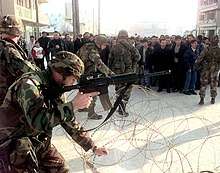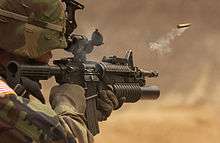M4 carbine
The M4 Carbine is a lighter and shorter variant of the M16A2 assault rifle. The M4 is a 5.56×45mm NATO, air-cooled, gas-operated,[lower-alpha 1] direct impingement, magazine-fed carbine. It has a 14.5 in (370 mm) barrel and a telescoping stock.
| Carbine, Caliber 5.56 mm, M4 | |
|---|---|
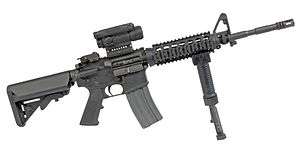 Colt M4 Modular Weapon System Carbine with RAS, M68 CCO and a GPS-02 grip pod | |
| Type | Selective-fire carbine Assault rifle |
| Place of origin | United States |
| Service history | |
| In service | 1994–present |
| Used by | See Users below |
| Wars | Colombian conflict Civil conflict in the Philippines Kosovo War War in Afghanistan (2001–present) Iraq War 2006 Lebanon War Mexican Drug War Russo-Georgian War Gaza War (2008–2009) Syrian Civil War[1] 2013 Lahad Datu standoff[2] Iraqi Civil War (2014–2017)[1] Battle of Arsal (2014) Battle of Marawi[3] |
| Production history | |
| Designed | 1983–1993 |
| Manufacturer | See Manufacturers below |
| Unit cost | $700 (avg. cost)[4] |
| Produced | 1991–present |
| Variants | M4A1 Mark 18 Mod 0 CQBR |
| Specifications | |
| Mass | 6.63 lb (3.01 kg) empty 7.75 lb (3.52 kg) with 30 rounds |
| Length | 33 in (838 mm) (stock extended) 29.75 in (756 mm) (stock retracted) |
| Barrel length | 14.5 in (368 mm) |
| Cartridge | 5.56×45mm NATO |
| Caliber | 5.56 mm (.223 in) |
| Action | Gas-operated, rotating bolt, Stoner expanding gas |
| Rate of fire | 700–950 round/min cyclic[5] |
| Muzzle velocity | 2,970 ft/s (910 m/s) (M855A1 round)[6] |
| Effective firing range | 500 m (550 yd)[7] |
| Feed system | 30-round box magazine or other STANAG magazines. Magazines with different capacities also available. |
| Sights | Iron sights or various optics |
The M4 is extensively used by the United States Armed Forces and is largely replacing the M16 rifle in United States Army and United States Marine Corps combat units as the primary infantry weapon[9][10] and service rifle. The M203 and M320 grenade launchers can be mounted on the lower hand guard of the carbine (see where bipod is attached on the photo). The distinctive step in its barrel is for mounting the M203 with the standard hardware. The M4 has semi-automatic and three-round burst firing modes (like the M16A2 and M16A4), while the M4A1 has semi-automatic and fully automatic firing modes (like the M16A1 and M16A3).
History
Following the adoption of the M16 rifle, carbine variants were also adopted for close quarters operations. The CAR-15 family of weapons served through the Vietnam War. However, these rifles had design issues, as "the barrel length was halved" to 10 inches, which "upset the ballistics", reducing its range and accuracy and leading "to considerable muzzle flash and blast, so that a large flash suppressor had to be fitted".[11] "Nevertheless, as a short-range weapon it is quite adequate and thus, [despite] its caliber, [the XM177 'Commando'] is classed as a submachine gun."[11] In 1982, the US Government requested Colt to make a carbine version of the M16A2. In 1983, the 9th Infantry Division requested a Quick Reaction Program (QRP) for a 5.56mm carbine as early as April 1983. The first model of the prototype M4 was built, and it was tested by the US Army and the Army's Armament Research and development Center (ARDC) in June 1983. It's basically a XM177E2 that fires 5.56x45mm NATO instead of the .223 Remington rounds, improved furniture, and a 1-7" barrel. The ARDC recommended additional commonality with the M16A2 rifle, as well as lengthening the barrel to 14.5". In January 1984, the US Army revised the QRP and redesignated the proposed 5.56mm carbine as the XM4 Carbine, given the name as the successor to the M3 Grease Gun, as an improved variant of the XM177E2. The Army formally approved the revised QRP in February 1984.
The second model was tested in May 1985 by the US Army and the USMC. The models had the XM177E2 receiver with a new A2 pistol grip, and were given a shorter 11.5-inch barrel, and longer 14.5-inch barrel for the bayonet and the M203 Grenade Launcher. The USMC preferred the 14.5-inch barrel. Colt also created the "XM4 IPR document" for the USMC and the US Army. The third model was made as early as May 1986, and it was tested from May 1986 through May 1987; at the time it had an A2 Upper Sight, and it had the M16A2's 1:7 inch rifle twist, to use the heavier 62-grain M855 rounds. The extended barrel improved the XM4's ballistics, reduced muzzle blast and gave the XM4 the ability to mount a bayonet and the M203 grenade launcher. The XM4 was also given the cartridge deflector, as well as other minor refinements. Colt was also focusing on other Colt Carbines, such as the Colt 723 and Colt 727 (M16A2 Government Carbine). In May 1991, the XM4 was renamed to the M4, and Colt made a manual for the M4. In 1993, the US Navy SEALs tests the M4's in Somalia alongside with the new M4A1. Colt stop working on improving the other Colt Carbines to do more work on the M4.
The M4 was officially accepted into service by the U.S. military in 1994, to replace the older XM177s, Colt Carbines, M16A2 rifle, and the M3 Grease Gun. It first saw action in the hands of U.S. troops deployed to Kosovo in 1999 in support of the NATO-led KFOR peacekeeping force. It would subsequently be used heavily by U.S. forces during the Global War on Terrorism, including Operation Enduring Freedom and Operation Iraqi Freedom. In the U.S. Army, the M4 had largely replaced M16A2s as the primary weapon of forward deployed personnel by 2005.[12] The M4 carbine also replaced most submachine guns and selected handguns in U.S. military service,[12] as it fires more effective rifle ammunition that offers superior stopping power and is better able to penetrate modern body armor.
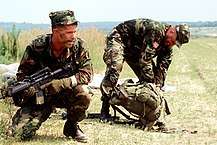
In 2007, the United States Marine Corps ordered its officers (up to the rank of Lieutenant Colonel) and staff non-commissioned officers to carry the M4 carbine instead of the M9 handgun.[13] This is in keeping with the Marine Corps doctrine, "Every Marine a rifleman". The Marine Corps, however, chose the full-sized M16A4 over the M4 as its standard infantry rifle. United States Navy corpsmen E5 and below are also issued M4s instead of the M9.[14] While ordinary riflemen in the Marine Corps were armed with M16A4s, M4s were fielded by troops in positions where a full-length rifle would be too bulky, including vehicle operators, and fireteam and squad leaders. As of 2013, the U.S. Marine Corps had 80,000 M4 carbines in their inventory.[15][16]
By July 2015, major Marine Corps commands were endorsing switching to the M4 over the M16A4 as the standard infantry rifle, just as the Army had done. This is because of the carbine's lighter weight, compact length, and ability to address modern combat situations that happen mostly within close quarters; if a squad needs to engage at longer ranges, the M27 IAR can be used as a designated marksman rifle. Approval of the change would move the M16 to support personnel, while armories already had the 17,000 M4s in the inventory needed to outfit all infantrymen who needed one.[17] In October 2015, Commandant Robert Neller formally approved of making the M4 carbine the primary weapon for all infantry battalions, security forces, and supporting schools in the U.S. Marine Corps. The switch was to begin in early 2016 and be completed by September 2016.[18] In December 2017, the Marine Corps revealed a decision to equip every Marine in an infantry squad with the M27, replacing the M4 in that part of the service.[19] MARSOC will retain the M4, as its shorter barrel is more suited to how they operate in confined spaces.[20]
Improved M4
On 1 July 2009, the U.S. Army took complete ownership of the M4 design.[21] This allowed companies other than Colt to compete with their own M4 designs. The Army planned on fielding the last of its M4 requirement in 2010.[21] On 30 October 2009, Army weapons officials proposed a series of changes to the M4 to Congress. Requested changes included an electronic round counter that records the number of shots fired, a heavier barrel, and possibly replacing the Stoner expanding gas system with a gas piston system.
The benefits of these changes, however, have come under scrutiny from both the military and civilian firearms community.[22][23] According to a PDF detailing the M4 Carbine improvement plans released by PEO Soldier, the direct impingement system would be replaced only after reviews were done comparing the direct impingement system to commercial gas piston operating system to find out and use the best available operating system in the U.S. Army's improved M4A1.[24]
In September 2010, the Army announced it would buy 12,000 M4A1s from Colt Firearms by the end of 2010, and would order 25,000 more M4A1s by early 2011. The service branch planned to buy 12,000 M4A1 conversion kits in early 2011. In late 2011, the Army bought 65,000 more conversion kits. From there the Army had to decide if it would upgrade all of its M4s.[25]
On 21 April 2012, the U.S. Army announced to begin purchasing over 120,000 M4A1 carbines to start reequipping front line units from the original M4 to the new M4A1 version. The first 24,000 were to be made by Remington Arms Company. Remington was to produce the M4A1s from mid-2013 to mid-2014.[26] After completion of that contract, it was to be between Colt and Remington to produce over 100,000 more M4A1s for the U.S. Army. Because of efforts from Colt to sue the Army to force them not to use Remington to produce M4s, the Army reworked the original solicitation for new M4A1s to avoid legal issues from Colt.[27] On 16 November 2012, Colt's protest of Remington receiving the M4A1 production contract was dismissed.[28] Instead of the contract being re-awarded to Remington, the Army awarded the contract for 120,000 M4A1 carbines worth $77 million to FN Herstal on 22 February 2013.[29][30] The order is expected to be completed by 2018.[31]
Army upgrades
The M4 product improvement program (PIP) is the effort by the U.S. Army to modernize its inventory of M4 service rifles. Phase I consists of converting and replacing regular M4s with the M4A1 version. This variant of the rifle is fully automatic and has a heavier barrel, and is given ambidextrous fire controls. Phase II of the PIP explored developing a new bolt carrier. 11 designs were submitted. The competition was scheduled to conclude in summer 2013, but ended in April 2012. Over six months of testing revealed that the current bolt carrier assembly outperformed the competing designs, especially in the areas of reliability, durability, and high-temp and low-temp tests. Phase II also includes a competition for a free-floating forward rail assembly. The Army may award contracts to up to three finalists in early 2013, with the selection of a final winner in early 2014. If the Army determines that the winning rail system should be procured, delivery of new rail is anticipated by the summer of 2014.[32]
In March 2015, the Army launched a market survey to see what the small-arms industry could offer to further enhance the M4A1 to an "M4A1+" standard. Several upgrade options include an extended forward rail that will allow for a free-floated barrel for improved accuracy with a low-profile gas block that would do away with the traditional triangular fixed front sight, removable front and rear flip-up back-up iron sights, a coyote tan or "neutral color" rail for reduced visual detection, a more effective flash suppressor/muzzle brake, an improved charging handle, and a new single-stage trigger module.[33] In June 2016, the M4A1+ was canceled after reviewing the offerings and determining that there were no major upgrades currently offered.[34]
Design
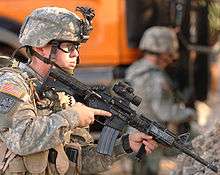
The M4 and its variants fire 5.56×45mm NATO (and .223 Remington) ammunition, and are gas-operated, magazine-fed, selective fire firearms with either a multi-position telescoping stock or a fixed A2 or LE tactical stock.[35]
The M4 is a shorter and lighter variant of the M16A2 rifle, with 80% parts commonality.[12] The M4 is similar to much earlier compact M16 versions, such as the 1960s-era XM177 family. Some of those visual similarities are obvious in both weapons.

As with many carbines, the M4 is handy and more convenient to carry than a full-length rifle. The price is slightly inferior ballistic performance compared to the full-size M16, with its 5.5" (14 cm) longer barrel. This becomes most apparent at ranges of 200 yards (180 m) and beyond.
While the M4's maneuverability makes it a candidate for non-infantry troops (vehicle crews, clerks and staff officers), it also makes it ideal for close quarters battle (CQB). The M4, along with the M16A4, have mostly replaced the M16A2 in the Army and Marines. The U.S. Air Force, for example, has transitioned completely to the M4 for Security Forces squadrons, while other armed personnel retain the M16A2. The US Navy uses M4A1s for Special Operations and vehicle crews.
Some features of the M4 and M4A1 compared to a full-length M16-series rifle include:
- Compact size
- Shortened barrel 14.5 in (370 mm), which includes the shorter carbine gas system.
- Telescoping buttstock
However, there have been some criticisms of the carbine, such as lower muzzle velocities and louder report due to the shorter barrel, additional stress on parts because of the shorter gas system, and a tendency to overheat faster than the M16A2.
Accessories
Like all the variants of the M16, the M4 and the M4A1 can be fitted with many accessories, such as night vision devices, flash suppressors, laser pointers, telescopic sights, bipods, either the M203 or M320 grenade launchers, the M26 MASS shotgun, forward hand grips, and anything else compatible with a MIL-STD-1913 Picatinny rail.
Other common accessories include the AN/PEQ-2, AN/PEQ-15 multi-mode laser, AN/PEQ-16 Advanced Combat Optical Gunsight (ACOG), and M68 CCO. EOTech holographic weapon sights are part of the SOPMOD II package. Visible and IR (infrared) lights of various manufacturers are also commonly attached using various mounting methods. As with all versions of the M16, the M4 accepts a blank-firing attachment (BFA) for training purposes.
In January 2017, a USMC unit deployed with suppressors mounted to every infantry M4 service weapon. Exercises showed that having all weapons suppressed improved squad communication and surprise during engagements; disadvantages included additional heat and weight, increased maintenance, and the greater cost of equipping so many troops with the attachment.[36] In July 2020, the Marine Corps announced it would be ordering suppressors for use by all M4 carbines used by close combat units.[37]
Feedramps
M4 feedramps are extended from the barrel extension into the upper receiver. This can help alleviate feeding problems that may occur as a result of the increased pressure of the shortened gas system of the M4. This problem is primarily seen in full-auto applications.
SOPMOD Block I

U.S. Special Operations Command (USSOCOM) developed the Special Operations Peculiar Modification (SOPMOD) Block I kit for the carbines used by units operating under its command. The kit features an M4A1, a Rail Interface System (RIS) handguard developed by Knight's Armament Company, a shortened quick-detachable M203 grenade launcher and leaf sight, a KAC sound suppressor, a KAC back-up rear sight, an Insight Technologies AN/PEQ-2A visible laser/infrared designator, along with Trijicon's ACOG TA-01NSN model and Reflex sights, and a night vision sight. This kit was designed to be configurable (modular) for various missions, and the kit is currently in service with special operations units.
SOPMOD Block II
.jpg)
A second-generation SOPMOD kit (now known as SOPMOD II) includes innovative optics, such as the Elcan Specter DR, Trijicon's ACOG TA01 ECOS model, and the EOTech 553. Block II uses the RIS II rails manufactured by Daniel Defense in both a 9.5 and 12.5 inch length.
Variants
Except for the first delivery order, all U.S. military-issue M4 and M4A1 carbines possess a flat-top NATO M1913-specification (Picatinny) rail on top of the receiver for attachment of optical sights and other aiming devices—Trijicon TA01 and TA31 Advanced Combat Optical Gunsights (ACOG), EOTech 550 series holographic sights, and Aimpoint M68 Close Combat Optic (M68 CCO) being the favorite choices—and a detachable rail-mounted carrying handle. Standards are the Colt Model 920 (M4) and 921 (M4A1).
Variants of the carbine built by different manufacturers are also in service with many other foreign special forces units, such as the Australian Special Air Service Regiment (SASR). While the SASR uses weapons of essentially the same pattern built by Colt for export (Colt uses different models to separate weapons for the U.S. military and those for commercial/export purposes), the British SAS uses a variant on the basic theme, the Colt Canada (formerly Diemaco) C8SFW.
XM177E2
The XM177E2 was used in the military since July 1967 until 1994 when it was replaced by the M4. The weapon, however, was at its prototype stage, and it was used as a testing weapon to see how it can be used in combat. In 1966, Colt introduced the XM177, which was an improved variant of the CAR-15 Carbine. The Colt 609 was used by the US Army, the US Navy Seals, and the MACV-SOG, referred as the XM177E1. The USAF however used the Colt 610, which is referred to as the GAU-5A, which became known as the GUU-5P. The XM177E1 does have problems with weapon jamming, however it does have positive reviews, and some soldiers preferred the XM177 over the M16. Mainly because it was shorter, lighter, and easier to handle. In 1967, Colt adopted the Colt 629, which is known as the XM177E2. The XM177E2 has some improvements over the M16A1, and Is prone to jamming less than the older variants. The weapon quickly became a favorite of the MACV-SOG. In 1983, Colt and the US Army start making a variant of the XM177E2 that fires 5.56mm NATO rounds. In 1984, the new XM177E2 was officially referred to as the XM4, and the result will eventually become the M4.
M4 MWS (Modular Weapon System)
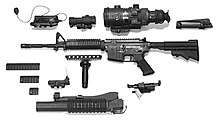
Colt Model 925 carbines were tested and fitted with the Knight's Armament Corporation (KAC) M4 RAS under the designation M4E2, but this designation appears to have been scrapped in favor of mounting this system to existing carbines without changing the designation. The U.S. Army Field Manual specifies for the Army that adding the Rail Adapter System (RAS) turns the weapon into the M4 MWS or Modular Weapon System.
M4A1
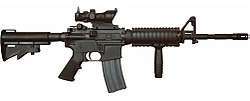
The M4A1 carbine is a fully automatic variant of the basic M4 carbine intended for special operations use. The M4A1 was introduced in 1993, and was in service in 1994. The M4A1 was the first M4 model with the removable carry handle. The M4A1 has a "S-1-F" (safe/semi-automatic/fully automatic) trigger group, while the M4 has a "S-1-3" (safe/semi-automatic/3-round burst) trigger group. The M4A1 is used by almost all U.S special operation units including, but not limited to, Marine Force Recon, Army Rangers, Army Special Forces, Navy SEALs, United States Air Force Pararescue and Air Force Combat Control Teams. It has a maximum effective range of about 500 to 600 meters (550–660 yd).[7] The fully automatic trigger gives a more consistent trigger pull, which leads to better accuracy.[38] According to Mark A. Westrom, owner of ArmaLite, Inc., automatic fire is better for clearing rooms than burst fire.[39]
In the last few years, M4A1 carbines have been refitted or received straight from the factory with barrels with a thicker profile under the handguard. This is for a variety of reasons such as heat dissipation during full-auto, and accuracy as a byproduct of barrel weight. These heavier barrel weapons are also fitted with a heavier buffer known as the H2. Out of three sliding weights inside the buffer, the H2 possesses two tungsten weights and one steel weight, versus the standard H buffer, which uses one tungsten weight and two steel weights. These weapons, known by Colt as the Model 921HB (for Heavy Barrel), have also been designated M4A1, and as far as the government is concerned the M4A1 represents both the 921 and 921HB.
Conversion of M4s to the M4A1 began in 2014, the start of all U.S. Army forces being equipped with the automatic variant.[40] Though in service with special forces, combat in Afghanistan showed the need for providing automatic suppression fires during fire and movement for regular soldiers. The 101st Airborne Division began fielding new-built M4A1s in 2012, and the U.S. 1st Infantry Division became the first unit to convert their M4s to M4A1-standard in May 2014. Upgrades included a heavier barrel to better dissipate heat from sustained automatic firing, which also helps the rifles use the M855A1 EPR that has higher proof pressures and puts more strain on barrels. The full-auto trigger group has a more consistent trigger pull, whereas the burst group's pull varies on where the fire control group is set, resulting in more predictable and better accuracy on semi-automatic fire. Another addition is an ambidextrous selector lever for easier use with left-handed shooters. The M4-M4A1 conversion only increases weapon weight from 7.46 lb (3.38 kg) to 7.74 lb (3.51 kg), counting a back-up iron sight, forward pistol grip, empty magazine, and sling. Each carbine upgrade costs $240 per rifle, for a total cost of $120 million for half a million conversions. Three hundred conversions can be done per day to equip a brigade combat team per week, with all M4A1 conversions to be completed by 2019.[41][42]
Mark 18 CQBR
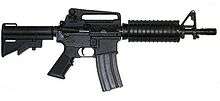
The Mk 18 Close Quarters Battle Receiver is a variant of M4A1 with a 10.3-inch barrel upper receiver.[43] Current contractors for the Mark 18 are Colt and Lewis Machine & Tool (LMT) NSN 1005-01-527-2288.
Enhanced M4
For the Individual Carbine competition, Colt submitted their Enhanced M4 design, also known as the Colt Advanced Piston Carbine (APC). The weapon has a suppression-ready fluted barrel, which is lighter and cools better than previous M4 barrels. It is claimed to have "markedly better" accuracy. To improve reliability, Colt used an articulating link piston (ALP), which "reduces the inherent stress in the piston stroke by allowing for deflection and thermal expansion".[44] In traditional gas piston operating systems, the force of the piston striking the bolt carrier can push the bolt carrier downwards and into the wall of the buffer tube, leading to accelerated wear and even chipped metal. This is known as carrier tilt. The ALP allows the operating rod to wiggle to correct for the downward pressure on the bolt and transfers the force straight backwards in line with the bore and buffer assembly, eliminating the carrier tilt. This relieves stress on parts and helps to increase accuracy.[45] The Individual Carbine competition was canceled before a winning weapon was chosen.[38]
M4 Commando
The modern Model 933 has a "flattop" receiver, with a removable carrying handle and a MIL-STD-1913 Picatinny rail, with semi-automatic and automatic fire. The Model 935 Commando has the features of the Model 933, but has three-round burst fire instead of automatic. Though originally called the M16A2 Commando, Colt markets them as the M4 Commando around 1995.
Armwest LLC M4
In 2014, American firearms designer Jim Sullivan provided a video interview regarding his contributions to the M16/M4 family of rifles when working for Armalite. A noted critic of the M4, he illustrates the deficiencies found in the rifle in its current configuration. In the video, he demonstrates his "Arm West LLC modified M4", with enhancements he believes necessary to rectify the issues with the weapon. Proprietary issues aside, the weapon is said to borrow features in his prior development, the Ultimax. Sullivan has stated (without exact details as to how) the weapon can fire from the closed bolt in semi-automatic and switch to open bolt when firing in fully automatic, improving accuracy. The weight of the cyclic components of the gun has been doubled (while retaining the weapon's weight at less than 8 pounds). Compared to the standard M4, which in automatic fires 750-950 rounds a minute, the rate of fire of the Arm West M4 is heavily reduced both to save ammunition and reduce barrel wear. The reduced rate also renders the weapon more controllable and accurate in automatic firing.[46]
Performance
.jpg)
The M4 carbine has been used for close quarters operations where the M16 would be too long and bulky to use effectively. It has been a compact, light, customizable, and accurate weapon. This has come at the cost of reliability and maintainability. Failure to maintain the M4 causes malfunctions. This became apparent as it saw continued use in the sandy environments of Iraq and Afghanistan.[47] Despite this, in post-combat surveys, 94 percent of soldiers rated the M4 as an effective weapons system.[48]
Early feedback
By late 2002, 89 percent of U.S. troops reported they were confident with the M4, but they had a range of problems. 34 percent of users said the handguards rattled and became excessively hot when firing, and 15 percent had trouble zeroing the M68 Close Combat Optic. 35 percent added barber brushes and 24 percent added dental picks to their cleaning kits. There were many malfunctions, including 20 percent of users experiencing a double feed, 15 percent experiencing feeding jams, and 13 percent saying that feeding problems were due to magazines. 20 percent of users were dissatisfied with weapon maintenance. Some had trouble locking the magazine into the weapon and having to chamber a round in order to lock the magazine. Soldiers also asked for a larger round to be able to kill targets with one shot. New optics and handguards made usage of the M4 easier, and good weapon maintenance reduced the number of misfeeds.[49]
2006 CNA report
In December 2006, the Center for Naval Analyses released a report on U.S. small arms in combat. The CNA conducted surveys on 2,608 troops returning from combat in Iraq and Afghanistan over the past 12 months. Only troops who fired their weapons at enemy targets were allowed to participate. 917 troops were armed with M4 Carbines, making up 35 percent of the survey. 89 percent of M4 users (816 troops) reported they were satisfied with the weapon. 90 percent (825 troops) were satisfied with handling qualities such as handguards, size, and weight. M4 users had the highest levels of satisfaction with weapon performance, including 94 percent (862 troops) with accuracy, 92 percent (844 troops) with range, and 93 percent (853 troops) with rate of fire. Only 19 percent of M4 users (174 troops) reported a stoppage, and 82 percent of those that experienced a stoppage said it had little impact on their ability to clear the stoppage and re-engage their target. 53 percent of the M4 users (486 troops) never experienced failures of their magazines to feed. 81 percent (743 troops) did not need their rifles repaired while in theater. 80 percent (734 troops) were confident in the M4's reliability, defined as level of soldier confidence their weapon will fire without malfunction, and 83 percent (761 troops) were confident in its durability, defined as the level of soldier confidence their weapon will not break or need repair. Both factors were attributed to high levels of soldiers performing their own maintenance. 54 percent of M4 users offered recommendations for improvements. 20 percent of requests were for greater bullet lethality, and 10 percent was better quality magazines, as well as other minor recommendations. Some M16 users expressed their desire to be issued the M4.[50] Some issues have been addressed with the issuing of the improved STANAG magazine in March 2009,[51][52] and the M855A1 Enhanced Performance Round in June 2010.[53]
2007 dust test
In the fall 2007, the Army tested the M4 against three other carbines in "sandstorm conditions" at Aberdeen Proving Ground, Maryland: the Heckler & Koch XM8, Fabrique Nationale de Herstal SOF Combat Assault Rifle (SCAR) and the Heckler & Koch HK416. Ten of each type of rifle were used to fire 6,000 rounds each, for a total of 60,000 rounds per rifle type.[54] The M4 suffered far more stoppages than its competitors: 882 stoppages, 19 requiring an armorer to fix. The XM8 had the fewest stoppages, 116 minor stoppages and 11 major ones, followed by the FN SCAR with 226 stoppages and the HK416 with 233.[55][56]
Despite 863 minor stoppages—termed "class one" stoppages, which require 10 seconds or less to clear, or "class two" stoppages, which require more than ten seconds to clear—the M4 functioned well, with over 98 percent of the 60,000 total rounds firing without a problem. The Army said it planned to improve the M4 with a new cold-hammer-forged barrel to give longer life and more reliable magazines to reduce the stoppages. Magazine failures caused 239 of the M4's 882 failures. Army officials said the new magazines could be combat-ready by spring if testing went well.[57] The Army began issuing an improved STANAG magazine in March 2009.[51][52]
According to the Army, the M4 only suffered 296 stoppages and said that the high number reported could be attributed to discrepancies in the scoring process. The Army testing command stated that, if the number of stoppages caused by a broken part met some threshold, they would be eliminated from the final report pending redesign of the part. Colt also claimed that the testing conditions were unfair to the M4, as the M4s used in the test were normal guns from active inventory, with remaining service life varying randomly. Further, the trial M4s had burst-mode fire groups, which are more complicated and prone to failure than the fully automatic fire groups the other manufacturers presented for testing.[58]
There were three extreme dust tests performed in 2007. The second Summer 2007 results showed a large difference from the later fall test with the M4 having 148 class 1 stoppages due to rifle malfunctions and 148 class 1 stoppages due to magazine stoppages. The full-size M16 rifle had 61 stoppages during the same extreme dust test.[59]
Reliability
In early 2010, two journalists from the New York Times spent three months with soldiers and Marines in Afghanistan. While there, they questioned around 100 infantrymen about the reliability of their M4 Carbines, as well as the M16 rifle. Troops did not report reliability problems with their rifles. While only 100 troops were asked, they fought at least a dozen intense engagements in Helmand Province, where the ground is covered in fine powdered sand (called "moon dust" by troops) that can stick to firearms. Weapons were often dusty, wet, and covered in mud. Intense firefights lasted hours with several magazines being expended. Only one soldier reported a jam when his M16 was covered in mud after climbing out of a canal. The weapon was cleared and resumed firing with the next chambered round. Furthermore, a Marine Chief Warrant Officer reported that there were no issues with his battalion's 700 M4s and 350 M16s.[60]
The reliability of the M4 has increased as the design was upgraded. In 1990, the M4 was required to fire 600 mean rounds between stoppages using M855 ammunition. In 2013, the current M4A1 version can fire 1,691 mean rounds between stoppages using M855A1 ammunition.[61]
During the 2009 Marine Corps Infantry Automatic Rifle testing, the Colt IAR displayed a MRBS of CLASS I/II Stoppages of 952 rounds, with a MRBEFF of Class III Stoppages of 60,000 rounds.[62]
Gas piston
An array of firearms accessory makers have offered gas piston conversion kits for the M4. The claimed benefits include less needed lubrication for the bolt carrier group to run reliably and reduced fouling. The argument against it is increased weight and reduced accuracy.[63] The Enhanced M4 uses an articulating link piston operating system.
Complicating the Army search for higher reliability in the M4 is a number of observations of M4 gas piston alternatives that suffer unintended design problems. The first is that many of the gas piston modifications for the M4 isolate the piston so that piston jams or related malfunction require the entire weapon be disassembled, such disassembly cannot be performed by the end-user and requires a qualified armorer to perform out of field, whereas almost any malfunction with the direct-impingement system can be fixed by the end-user in field. The second is that gas piston alternatives use an off-axis operation of the piston that can introduce carrier tilt, whereby the bolt carrier fails to enter the buffer tube at a straight angle, resulting in part wearing. This can also tilt the bolt during extraction, leading to increased bolt lug failures. The third is that the use of a sound suppressor results in hot gases entering the chamber, regardless of a direct-gas impingement or gas piston design choice. The gas piston system may also cause the firearm to become proprietary to the manufacturer, making modifications and changes with parts from other manufacturers difficult.[23][64]
Manufacturers
- Colt's Manufacturing Company, US
- Colt Canada in Ontario, Canada
- Lewis Machine and Tool Company in Milan, Illinois, US
- Bushmaster Firearms International, US
- U.S. Ordnance, US
- Remington Arms Company, US
- Daniel Defense in Black Creek, Georgia, US
- Forjas Taurus São Leopoldo, RS, Brazil
- FN Herstal, Belgium.
- SME Ordnance, Malaysia[65]
- Sarsilmaz, Turkey[66]
- Caracal International, United Arab Emirates
Trademark issues
The M4 was developed and produced for the United States government by Colt Firearms, which had an exclusive contract to produce the M4 family of weapons through 2011.[67] However, a number of other manufacturers offer M4-like firearms. Colt previously held a U.S. trademark on the term "M4".[68] Many manufacturers have production firearms that are essentially identical to a military M4, but with a 16" barrel. The Bushmaster M4 Type Carbine is a popular example. Civilian models are sometimes colloquially referred to as "M4gery" (/ɛmˈfɔːrdʒəri/ em-FOR-jər-ee, a portmanteau of "M4" and "forgery"). Colt had maintained that it retains sole rights to the M4 name and design. Other manufacturers had long maintained that Colt had been overstating its rights, and that "M4" had now become a generic term for a shortened AR-15. In April 2004, Colt filed a lawsuit against Heckler & Koch and Bushmaster Firearms, claiming acts of trademark infringement, trade dress infringement, trademark dilution, false designation of origin, false advertising, patent infringement, unfair competition, and deceptive trade practices. Heckler & Koch later settled out of court, changing one product's name from "HK M4" to "HK416". However, on December 8, 2005, a District Court judge in Maine granted a summary judgment in favor of Bushmaster Firearms, dismissing all of Colt's claims except for false advertising. On the latter claim, Colt could not recover monetary damages. The court also ruled that "M4" was now a generic name, and that Colt's trademark should be revoked.[69]
Users




.svg.png)







.svg.png)




















































U.S. civilian ownership
Sales of select-fire or fully automatic M4s by Colt are restricted to military and law enforcement agencies. No private citizen can own an M4 in a select-fire or fully automatic configuration, as this model of fully automatic rifle was developed after the 1986 ban on fully automatic weapons available to be purchased by US citizens under the Firearms Owners' Protection Act of 1986. While many machine guns can be legally owned with a proper tax stamp from the Bureau of Alcohol, Tobacco, Firearms and Explosives, an amendment to the Firearm Owners Protection Act of 1986 barred the transfer to private citizens of machine guns made or registered in the U.S. after May 19, 1986. The only exception was for Special Occupational Taxpayers (SOT), who are licensed machine gun dealers with demonstration letters, manufacturers, and those dealing in exports and imports. As such, only the earliest Colt M4 prototypes built prior to 1986 would be legal to own by non-SOT civilians. The modular nature of the AR-15 design, however, makes it relatively simple to fit M4-specific components to a "pre-'86" select-fire AR-15 lower receiver, producing an "M4" in all but name.
The M4 falls under restrictions of Title II of the National Firearms Act. The 14.5 inch barrel makes the M4 a Short Barrel Rifle (SBR) and select fire capability (semi-automatic and fully automatic or burst-automatic) makes the M4 a machine gun. Civilian replicas of the M4 typically have 16 inch barrels (or standard 14.5-inch M4 barrels with permanently attached flash suppressors with a total length of 16 inches) and are semi-automatic-only to meet the legal definition of a rifle under the Gun Control Act. Civilian-legal M4s are also popular with police as a patrol carbine.
See also
- Comparison of the AK-47 and M16
- SIG Sauer SIG516, an M16-based rifle
- LWRC M6, a competing M4-based weapon
- Brown Enhanced Automatic Rifle, a competing M16/M4-based weapon
- Remington R4, a competing M4-based weapon
Replacement attempts
- XM8 rifle: canceled in 2005
- Close Quarters Battle Receiver: successful replacement
- Individual Carbine: canceled in 2013. Candidates included:
- Barrett REC7 PDW
- Beretta ARX 160
- Remington ACR
- FN SCAR
- Heckler & Koch HK416
- LWRC M6A4
- Robinson Arms XCR
- SIG 556
- Colt ACC-M
References
Notes
- Stoner expanding gas system per patent.[8]
Citations
- Snow, Shawn (2017-05-07). "Syrian Kurds are now armed with sensitive US weaponry, and the Pentagon denies supplying it". Military Times. Archived from the original on 2019-04-22. Retrieved 2019-04-22.
- "Intruders photo in Sabah". Sabah Daily (in Malay). Archived from the original on 6 March 2013. Retrieved 2 March 2013.
- "Arming the Maute Group in Marawi City". The Firearm Blog. 22 June 2017. Archived from the original on 14 November 2017. Retrieved 23 November 2017.
- Curtis, Rob (2012-04-20). "U.S. Army places order for 24,000 M4A1 carbines with Remington". Military Times. Archived from the original on 2012-06-24. Retrieved 2012-08-23.
- "Colt M4 Carbine Technical Specifications". Colt.com. Archived from the original on September 21, 2014.
- "M855A1 Enhanced Performance Round (EPR), LTC Philip Clark, Product Manager Small Caliber Ammunition, April 2012" (PDF). Archived from the original (PDF) on 2017-01-25. Retrieved 2017-02-25.
- "M-4 Carbine". U.S. Army Fact Files. United States Army. Archived from the original on 28 November 2013. Retrieved 13 September 2008.
- "US2951424A: Gas operated bolt and carrier system". U.S. Patent Office. September 6, 1960.
- "Small Arms–Individual Weapons" (PDF). 3 November 2010. Archived (PDF) from the original on 9 February 2011. Retrieved 8 November 2010.
- "Commandant approves M4 as standard weapon for Marine infantry". Archived from the original on 2016-04-25. Retrieved 2015-11-03.
- Military Small Arms Of The 20th Century, 7th Edition, 2000 by Ian V. Hogg & John S. Weeks, p. 166
- "The Design & Development of the M-4 Carbine". Special Operations.com. Archived from the original on 2008-10-25. Retrieved 2008-11-08.
- "Officers, staff NCOs to be issued M4s". Marine Corps Times. 25 June 2007. Archived from the original on 18 December 2014 – via Leatherneck.com forums. Alt URL
- "New Assignment Rationale for Individual Weapons". U.S. Marine Corps. 22 June 2007. Archived from the original on 29 November 2014.
- "M27 First Impressions". TheFirearmBlog.com. 20 April 2013. Archived from the original on 8 May 2013.
- "Corps exploring rifle upgrades". Military Times. 29 April 2013. Archived from the original on 1 May 2013.
- "Marine brass endorses infantry plan to ditch M16 for M4". Military Times. 27 July 2015. Archived from the original on 30 July 2015.
- "Commandant approves M4 as standard weapon for Marine infantry". Military Times. 26 October 2015. Archived from the original on 27 October 2015.
- "M27s and 'Head-to-Toe' Gear Overhaul on the Way for Marine Grunts". Military.com. 5 January 2018. Archived from the original on 7 January 2018.
- "Marine Raiders don't want any M27s". Marine Corps Times. 19 February 2018. Archived from the original on 24 February 2018.
- Cox, Matthew (2009-07-07). "Army acquires rights to M4". Army Times. Retrieved 2009-08-18.
- Cox, Matthew (2009-11-21). "Major revamp possible for M4 carbine". Army Times. Archived from the original on 2012-07-18. Retrieved 2009-11-21.
- Pannone, Mike (2010-03-19). "The Big M4 Myth: "Fouling caused by the direct impingement gas system makes the M4/M4A1 Carbine unreliable."". Defensive Review. Archived from the original on 2011-08-14. Retrieved 2011-07-27.
- "Dual Path Strategy: M4 PIP" (PDF). 7 September 2011. Retrieved 7 September 2011.
- Lamothe, Dan. "Corps to pass on Army upgrades to M4". Marine Corps Times. Archived from the original on 25 September 2010. Retrieved 13 September 2010.
- "US Army Places Order For 24000 M4 Carbines With Remington". Military Times. Archived from the original on 24 June 2012. Retrieved 24 April 2012.
- "Colt again blocks Army's advanced M4 plans". Military.com. 18 October 2012. Archived from the original on 27 September 2013.
- "GAO denies latest Colt M4 protest". Gearscout.com. Military Times. 28 November 2012. Archived from the original on 1 December 2012.
- "Army Awards New M4/M4A1 Contract to FN". Military.com. 23 February 2013. Archived from the original on 26 February 2013.
- "FN Manufacturing Wins Contract to Supply M4A1". TheFireArmBlog.com. 24 February 2013. Archived from the original on 28 February 2013.
- "FN Manufacturing to deliver M4/M4A1 Carbines to US Army". Strategic Defense Intelligence.com. 27 February 2013. Archived from the original on 27 September 2013.
- "M4 CARBINE PRODUCT IMPROVEMENT PROGRAM (PIP)". PEO Soldier Live. 23 August 2012. Archived from the original on 2 January 2013.
- "Army Wants Upgrades to Improve M4A1 Carbine's Performance, Accuracy". Military.com. 18 March 2015. Archived from the original on 20 March 2015.
- Jahner, Kyle (12 June 2016). "Army ditches plans for additional M4 carbine upgrades". Army Times.
- "Animation of the gas system of the M4 carbine". Militarytimes.com. Archived from the original on 2009-12-28. Retrieved 2010-08-30.
- "Marine Unit in Norway First to Deploy with Rifle Suppressors". Military.com. 11 May 2017. Archived from the original on 15 May 2017.
- The Marine Corps Plans on Fielding Suppressors to Infantry Squads Starting this Year. Military.com. 13 July 2020.
- "Army Kills Competition to Replace M4". Military.com. 13 June 2013. Archived from the original on 22 September 2013.
- "Carbine Competition Fails to Find Improvement Over Current Weapon". National Defense Magazine. August 2013. Archived from the original on 18 October 2015.
- Bacon, Lance M. (30 April 2011). "Improved carbines headed your way". Army Times. Retrieved 30 April 2011.
- "Beefier carbines en route to Soldiers". U.S. Army. 22 May 2014. Archived from the original on 3 September 2014.
- "Army infantry beginning adoption of upgraded M4A1 carbines". Guns.com. 24 May 2014. Archived from the original on 3 September 2014.
- Johnson, Jeff. "CQB Receiver – M4A1 Carbine with10-Inch Upper Receiver" (Power point presentation). Scribd.com. US Naval Surface Warfare Center Crane. Archived from the original on November 4, 2011. Retrieved May 2, 2012.
- "Enhanced M4". Defense Review. 29 November 2011. Archived from the original on 21 May 2012.
- "Colt's Advanced Piston Carbine, the LE6940P In Stores". InvestorVillage.com. Archived from the original on 3 December 2013.
- "Interview & Shooting: Jim Sullivan, AR-15 Designer". Full30: INRANGE TV. 26 November 2014. Archived from the original on 2015-02-28.
- "M4 Carbine Controversy". Defense Industry Daily. Archived from the original on 13 July 2007.
- "Small Arms-Individual Weapons" (PDF). Archived (PDF) from the original on 12 December 2017. Retrieved 4 April 2015.
- Williams, Anthony G. "SA80: MISTAKE OR MALIGNED". Archived from the original on 29 May 2013.
- Russell, Sara M. (2006). "Soldier Perspectives on Small Arms in Combat" (PDF). CNA Corporation. Department of Defense. Archived from the original (PDF) on 31 August 2015.
- "Brownells shipping M16 magazines with anti-tilt follower to military". The Firearm Blog. 13 June 2009. Archived from the original on 21 September 2013.
- "New US Army M16 "Tan" Magazine". The Firearm Blog. 16 December 2009. Archived from the original on 21 September 2013.
- "Army begins shipping improved 5.56mm cartridge". Picatinny Arsenal. 24 June 2010. Archived from the original on 1 June 2013.
- Lowe, Christian (2007-12-18). "M4 Carbine Fares Poorly in Dust Test". Military.com. Military Advantage. Archived from the original on 2008-08-13. Retrieved 2008-09-13.
- "...And Here's the Rest of the M4 Story". Defense Tech. Military Advantage. 2007-12-18. Archived from the original on 2007-12-23. Retrieved 2008-09-13.
- Cox, Matthew (2007-12-19). "Newer carbines outperform M4 in dust test". Army Times. Army Times Publishing Company. Archived from the original on 2012-06-30. Retrieved 2019-07-24.
- Cox, Matthew (2007-12-17). "M4 may get tougher barrel, better mags". Army Times. Army Times Publishing Company. Archived from the original on 2012-07-21. Retrieved 2019-07-24.
- "The Army's M4 Carbine: Background and Issues for Congress" (PDF). Fas.org. 8 June 2010. Archived from the original (PDF) on 23 March 2015.
- Combat Tactics Fall 2008 Volume Six Number Two "True Grit" by David Crane
- Chivers, C.J. (July 7, 2010). "Examining the Complaints About American Rifle Reliability". The New York Times. Archived from the original on September 22, 2013.
- Cox, Matthew (June 14, 2013). "Army: Gun Makers Didn't Meet Reliability Standard". Military.com. Archived from the original on April 27, 2014.
- "USMC IAR Reliability Testing Results". Weaponsman. 2009. Archived from the original on April 12, 2017.
- "Best AR-15 Piston Uppers & Conversion Kits [2019]". Pew Pew Tactical. October 14, 2017.
- "15259frcov.fm" (PDF). Archived from the original (PDF) on 2015-08-31. Retrieved 2010-08-30.
- "Malaysia has licence to make M4 assault rifles". The Star. 2007-11-05. Archived from the original on 2008-10-03. Retrieved 2010-03-22.
- Watters, David. "The 5.56 X 45mm: 2005". Archived from the original on 2011-08-07. Retrieved 2010-03-10.
- "FindLaw's United States First Circuit case and opinions". Findlaw. Archived from the original on 2016-08-29. Retrieved 2016-08-09.
- US Trademark serial number 76335060 registration number 2734001
- "OpenJurist synopsis of denial of Colt's appeal to 08 Dec 2005 ruling". Openjurist.org. Archived from the original on 2 August 2009. Retrieved 2010-08-30.
- Petty Officer First Class David Votroubek (July–August 2008). "New Gear for Afghan Commandos". United States Army Logistics Management College. Archived from the original on 2009-08-01. Retrieved 2009-03-24.
- Soraya Sarhaddi Nelson (23 July 2007). "New Afghan Commandos Take to the Frontlines". National Public Radio. Archived from the original on 2009-08-02. Retrieved 24 March 2009.
- Watters, Daniel. "The 5.56 X 45mm: 2006". Archived from the original on 2011-03-01. Retrieved 2009-03-25.
- Watters, Daniel. "The 5.56 X 45mm: 2008". The Gun Zone. Archived from the original on 2010-01-04. Retrieved 2009-01-27.
- "FOTOT/ Ushtria shqiptare tregon "dhëmbët"". Gazeta Tema. Archived from the original on 2015-12-23. Retrieved 2016-01-06.
- "Colt Capitalizes on Foreign Military Sales Program - The Firearm Blog". 27 April 2017. Archived from the original on 1 June 2017. Retrieved 1 May 2017.
- "Clearance Divers, Maritime Tactical Operations". Australian Defence Jobs. Archived from the original on 2010-11-02. Retrieved 2011-09-27.
- https://aqreqator.az/az/siyaset/862891
- "Dhaka Metropolitan Police SWAT - Overview". bdmilitary. Retrieved 22 February 2009.
- "Bangladesh Military Forces - BDMilitary.com". Retrieved 15 November 2014.
- "Bolivia Land Forces military equipment". Army Recognition. Retrieved 28 November 2019.
- "PMERJ". Polícia Militar do Estado do Rio de Janeiro. Archived from the original on 7 June 2014.
- "DOU 05/07/2012 - Pg. 28 - Seção 3 - Diário Oficial da União - Diários JusBrasil". JusBrasil. Archived from the original on 29 November 2014. Retrieved 15 November 2014.
- "Canadian Police Militarization". Archived from the original on 2016-11-25. Retrieved 2016-11-25.
- "Croatian special forces with M4s". Archived from the original on July 17, 2011.
- RUČNÍ ZBRANĚ AČR (PDF) (in Czech). Ministerstvo obrany České republiky AVIS. 18 April 2007. ISBN 978-80-7278-388-5. Archived from the original (PDF) on 2012-02-29.
- "Chinese Special Forces Competing With AR-15 Rifles". TheFirearmBlog.com. Archived from the original on 29 December 2018. Retrieved 29 December 2018.
- "Soldiers from the Dominican Republic Special Forces fire the M4 Carbine rifle at targets down range at the shooting house in Sierra Piedras, Dominican Republic". nara.getarchive.net. 20 April 2004. Archived from the original on 9 February 2019. Retrieved 7 February 2019.
- "World Infantry Weapons: Egypt". World Inventory. Archived from the original on 2016-03-12. Retrieved 2018-01-26.
- Watters, Daniel. "The 5.56 X 45mm: 2007". Archived from the original on 2008-10-10. Retrieved 2009-03-25.
- Rottman, Gordon L. (20 December 2011). The M16. Weapon 14. Osprey Publishing. p. 60. ISBN 978-1-84908-691-2.
- Sof, Eric (22 April 2017). "Colt wins multimillion contract to sell M4 Carbines to Georgia, Iraq". Archived from the original on 2018-07-22. Retrieved 2018-06-03.
- Binnie, Jeremy; de Cherisey, Erwan (2017). "New-model African armies" (PDF). Jane's. Archived from the original (PDF) on 22 June 2017.
- "Greece Ministry of Public Order Press Office: Special Anti-Terrorist Unit" (PDF). Official Website of the Hellenic Police. July 2004. Archived from the original (PDF) on 2010-07-21. Retrieved 2009-10-13.
- "34. Bercsény László Különleges Műveleti Zászlóalj" [Bercsény László 34th Special Operations Battalion]. Archived from the original on October 18, 2017. Retrieved June 22, 2017.
- "Mizo cops to get foreign weapons". Meghalaya Times. June 13, 2010. Archived from the original on October 9, 2011. Retrieved September 27, 2011.
- "Mizoram Armed Police". Retrieved April 8, 2011.
- Guerin, Bill (June 16, 2007). "Another success for Detachment 88". Asia Times Online. Archived from the original on February 2, 2009. Retrieved January 20, 2009.
- "Kopassus & Kopaska – Specijalne Postrojbe Republike Indonezije" [Kopassus & Kopaska - Special Forces of the Republic of Indonesia] (in Croatian). Hrvatski Vojnik Magazine. Archived from the original on August 22, 2010. Retrieved 2010-06-12.
- Giordono, Joseph (2007-05-16). "Iraqi soldiers switching over to M-16s and M-4s". Stars & Stripes. Archived from the original on 2009-08-01. Retrieved 2009-03-25.
- CJSOTF-AP Public Affairs. "U.S. Special Forces, Iraqi army ops: Raids result in 102 detainees, large weapons cache, no losses" (PDF). p. 8. Archived from the original (PDF) on 2009-03-27. Retrieved 2009-03-25.
- Watters, Daniel. "The 5.56 X 45mm: 2000–2001". Archived from the original on October 10, 2008. Retrieved March 25, 2009.
- "Armi > Fucili d'Assalto > Colt M4" (in Italian). Archived from the original on 2011-07-22. Retrieved 2010-07-18. . colmoschin.it
- "Daigo Ishiba's statement" 全文掲載:飯柴大尉の声明文 (in Japanese). Archived from the original on 2 February 2009. Retrieved 12 January 2009.
- US Directorate of Defense Trade Controls. Notifications to the 108th Congress (November 2004)
- Christopher J. Castelli (September 2008). "Department of Defense to equip Lebanon's Special Forces with Small Arms, Vehicles" (PDF). DISAM Journal. Archived (PDF) from the original on 2009-03-27. Retrieved 2009-02-08.
- Thompson, Leroy (December 2008). "Malaysian Special Forces". Special Weapons. Archived from the original on 2009-12-30. Retrieved 2009-12-17.
- "Legacies of War in the Company of Peace: Firearms in Nepal" (PDF). Nepal Issue Brief. Small Arms Survey (2): 5. May 2013. Archived (PDF) from the original on 2014-07-08. Retrieved 2019-01-08.
- "Unofficial New Zealand Special Air Service page". Archived from the original on 2004-11-12. Retrieved 2009-03-25.
- "Split second decisions: police rules of engagement". The Sunday Star-Times. 1 February 2009. Archived from the original on 12 October 2012. Retrieved 15 October 2011.
- "Replacement due for police rifles". New Zealand Police. 19 May 2005. Archived from the original on 8 March 2016. Retrieved 8 March 2016.
- "Pakistan Army". Archived from the original on May 13, 2013.
- "U.S. Army Weapon Systems Handbook 2012" (PDF). Archived (PDF) from the original on 2017-12-12. Retrieved 2013-04-25.
- Adnan Abu Amer (2015-05-10). "Security services drain Palestine's budget". Al-Monitor. Archived from the original on 2017-05-05. Retrieved 2017-06-08.
- "Philippine Army acquires R4 carbines". Archived from the original on March 29, 2014. Retrieved 15 November 2014.
- "US-based Remington wins bid to supply 50,000 M4 rifles for AFP, company rep says". Interaksyon.com. Archived from the original on May 6, 2013. Retrieved May 4, 2013.
- "Small Arms Repair and Upgrade Unit". Bullet-in. June 2015.
- Schroeder, Matt (2013). "Captured and Counted: Illicit Weapons in Mexico and the Philippines" (PDF). Small Arms Survey 2013: Everyday Dangers. Cambridge University Press. p. 303. ISBN 978-1-107-04196-7. Archived from the original on 2019-03-21. Retrieved 2019-06-05.
- Sebastian Miernik. "Uzbrojenie i wyposażenie" [Armaments and equipment] (in Polish). Grom.mil.pl. Archived from the original on 14 August 2011. Retrieved 30 August 2010.
- "Destacamento de Ações Especiais (DAE)" (in Portuguese). Tropaselite.t35.com. Archived from the original on 2010-08-20. Retrieved 2010-08-30.
- "Спецподразделение "Группа "Альфа" ФСБ РФ. История, с иллюстрациями" (in Russian). Archived from the original on 2016-12-10.
- "Senegal received 2 200 M4 carbines from the US". defenceWeb. 26 July 2019.
- "Moderan "gradski" karabin" [A modern "city" carbine] (in Serbian). Kalibar.rs. Archived from the original on 2012-02-27. Retrieved 2010-08-30.
- "Singapurske Specijalne Postrojbe" [Singapore Special Forces] (in Croatian). Hrvatski Vojnik Magazine. Archived from the original on October 15, 2009. Retrieved 2009-10-25.
- "屏東縣警察局保安隊 裝備介紹" [Equipment introduction]. Ptpolice.gov.tw (in Chinese). 2007-01-29. Archived from the original on 2008-05-18. Retrieved 2011-09-27.
- "Colt contracted for M4, M4A1 rifles for foreign military sales". UPI. Archived from the original on 2018-09-21. Retrieved 2018-09-21.
- "Turkey Small Arms List (Current and Former Types)". Military Factory. Retrieved 28 November 2019.
Bushmaster M4-Type
- Watters, Daniel. "The 5.56 X 45mm: 1990–1994". Archived from the original on January 4, 2010. Retrieved March 25, 2009.
- Hogg, Ian (12 November 2002). Jane's Guns Recognition Guide (3rd ed.). Collins Reference. ISBN 000712760X.
External links
| Wikimedia Commons has media related to M4 carbine. |
